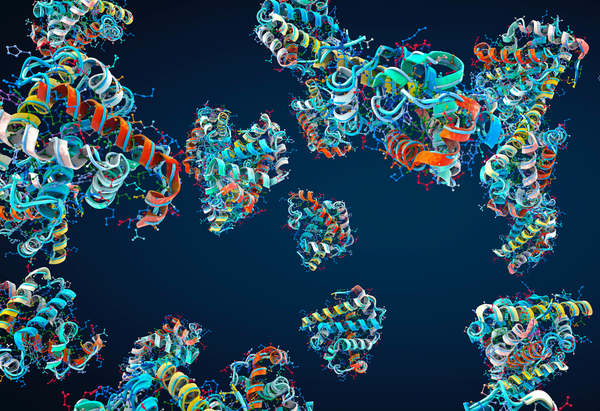The researchers behind the AlphaFold artificial-intelligence (AI) system have won one of this year’s US$3-million Breakthrough prizes—the most lucrative awards in science. Demis Hassabis and John Jumper, both at DeepMind in London, were recognized for creating the tool that has predicted the 3D structures of almost every known protein on the planet.
“Few discoveries so dramatically alter a field, so rapidly,” says Mohammed AlQuraishi, a computational biologist at Columbia University in New York City. “It’s really changed the practice of structural biology, both computational and experimental.”
The award was one of five Breakthrough prizes—awarded for achievements in life sciences, physics and mathematics—announced on 22 September.
Award-winning AI
AlphaFold was seeded from the success of DeepMind’s AlphaGo. This was the AI that in 2016 beat Lee Sedol, a master of the strategy game Go, in Seoul. “That was the pinnacle of gaming AI, but that was never supposed to be an end in itself,” says Hassabis. “I wanted to build AI to accelerate scientific discovery.” The day after returning from Seoul, the team turned its attention to protein folding.
The system created a stir in November 2020 by winning the biennial CASP contest (Critical Assessment of Structure Prediction), beating around 100 other software programs. An earlier version of AlphaFold had won in 2018, but not convincingly, forcing the team back to the drawing board. “With machine learning, it’s about finding the right balance between the architecture—the constraints imposed by the known underlying science—and the data,” says Jumper.
Since DeepMind released an open-source version of AlphaFold in July 2021, more than half a million researchers have used the machine-learning system, generating thousands of papers. In July this year, DeepMind released 200 million protein structures predicted from amino-acid sequences. So far, the data have been harnessed to tackle problems ranging from antibiotic resistance to crop resilience.
“This is a major breakthrough, not just because they developed the algorithm, but because they made it available and provided all those structures,” says Christine Orengo, a computational biologist at University College London. She adds that the achievement was made possible by a wealth of protein sequence data gathered by the global community.
Hassabis says that he was “stunned” to learn he had won a Breakthrough prize, and Jumper says he “could not believe it was for real”. Hassabis plans to donate some of his winnings to educational programmes aimed at increasing diversity, and also to initiatives supporting schools in rural Nepal.
Sleep science and cellular systems
Another life-sciences Breakthrough prize was awarded jointly to sleep scientists Masashi Yanagisawa at the University of Tsukuba, Japan, and Emmanuel Mignot at Stanford University in Palo Alto, California, for independently discovering that narcolepsy is caused by a deficiency of the brain chemical orexin.
Both researchers are “giants of the field” who enabled the condition to be definitively diagnosed, says Birgitte Rahbek Kornum, a neurophysiologist at the University of Copenhagen. “Narcolepsy severely affects quality of life, and this allowed patients to know exactly what’s wrong, instead of being told to ‘get a grip and stay awake’,” she says. The findings have also led to the development of drug treatments that are currently in clinical trials.
Yanagisawa says he is “deeply honoured” by the prize and plans to use the money to set up an endowment to fund research. “Stable support for young scientists to do exploratory work in Japan is problematic,” he says, noting that his own discovery was possible only because he was free to “go on a ‘fishing expedition’ with no guarantee of success”.
A third life-sciences prize is shared by Clifford Brangwynne at Princeton University in New Jersey and Anthony Hyman at the Max Planck Institute of Molecular Cell Biology and Genetics in Dresden, Germany, for discovering a mechanism by which cell contents can organize themselves by segregating into droplets.
Quantum pioneers
This year’s Breakthrough Prize in Fundamental Physics is shared between four founders of the field of quantum information: Peter Shor at the Massachusetts Institute of Technology in Cambridge; David Deutsch at the University of Oxford, UK; Charles Bennett at IBM in Yorktown, New York; and Gilles Brassard at the University of Montreal in Quebec. Their research laid the groundwork for the development of ultra-secure communications and computers that might one day outperform standard machines at some tasks.
“I was really surprised to learn I have been awarded the prize,” says Shor. “There is so much that others have done.” In the 1990s, Shor developed the first potentially useful quantum algorithm, which could one day enable quantum computers to speedily break large numbers down into their prime factors. This raises the possibility of cracking encryption codes used to secure much of today’s Internet traffic, which are based on large prime numbers. “This massive result proved that quantum computers were more than just another academic curiosity,” says Nikita Gourianov, a quantum physicist at the University of Oxford.
The Breakthrough Prize in Mathematics goes to Daniel Spielman, a mathematician at Yale University in New Haven, Connecticut. Spielman was recognized for multiple advances, including the development of error-correcting codes to filter out noise in high-definition television broadcasts.
The Breakthrough prizes were founded in 2012 by Yuri Milner, a Russian-Israeli billionaire. They are now sponsored by Milner and other Internet entrepreneurs, including Mark Zuckerberg, the chief executive of Meta (formerly Facebook).
This article is reproduced with permission and was first published on September 22 2022.
